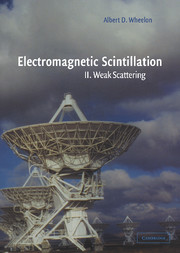Book contents
- Frontmatter
- Contents
- Preface
- 1 Introduction
- 2 The Rytov Approximation
- 3 Amplitude Variance
- 4 Spatial Covariance
- 5 The Power Spectrum and Autocorrelation
- 6 Frequency Correlations
- 7 Phase Fluctuations
- 8 Double Scattering
- 9 Field-strength Moments
- 10 Amplitude Distributions
- 11 Changes in Polarization
- 12 The Validity of the Rytov Approximation
- Appendix A Glossary of Symbols
- Appendix B Integrals of Elementary Functions
- Appendix C Integrals of Gaussian Functions
- Appendix D Bessel Functions
- Appendix E Probability Distributions
- Appendix F Delta Functions
- Appendix G Kummer Functions
- Appendix H Hypergeometric Functions
- Appendix I Aperture Averaging
- Appendix J Vector Relations
- Appendix K The Gamma Function
- Appendix L Green's Function
- Appendix M The Method of Cumulant Analysis
- Appendix N Diffraction Integrals
- Appendix O Feynman Formulas
- Author Index
- Subject Index
9 - Field-strength Moments
Published online by Cambridge University Press: 15 December 2009
- Frontmatter
- Contents
- Preface
- 1 Introduction
- 2 The Rytov Approximation
- 3 Amplitude Variance
- 4 Spatial Covariance
- 5 The Power Spectrum and Autocorrelation
- 6 Frequency Correlations
- 7 Phase Fluctuations
- 8 Double Scattering
- 9 Field-strength Moments
- 10 Amplitude Distributions
- 11 Changes in Polarization
- 12 The Validity of the Rytov Approximation
- Appendix A Glossary of Symbols
- Appendix B Integrals of Elementary Functions
- Appendix C Integrals of Gaussian Functions
- Appendix D Bessel Functions
- Appendix E Probability Distributions
- Appendix F Delta Functions
- Appendix G Kummer Functions
- Appendix H Hypergeometric Functions
- Appendix I Aperture Averaging
- Appendix J Vector Relations
- Appendix K The Gamma Function
- Appendix L Green's Function
- Appendix M The Method of Cumulant Analysis
- Appendix N Diffraction Integrals
- Appendix O Feynman Formulas
- Author Index
- Subject Index
Summary
All of the development so far has concentrated on the variances of phase and amplitude – or their correlations with respect to separation, time delay and frequency separation. We turn now to moments of the field strength itself. These are the quantities that are often measured in astronomical observations and terrestrial experiments. They are usually calculated with theories that characterize strong scintillation. It is significant that the Rytov approximation gives identical results for many of these quantities. This approach requires only the tools we have already developed.
The average field strength and mean irradiance set important reference levels for measurement programs. They are also needed in order to describe other features of propagation in random media. Accurate estimates for these quantities require both first- and second-order solutions in the Rytov expansion. These depend on the double-scattering expressions which were established for plane, spherical and beam waves in Chapter 8. Field-strength moments are more difficult to estimate because they contain the Born terms in exponential form. We shall learn that the mean field is attenuated very rapidly with distance. By contrast, the mean irradiance for plane and spherical waves is everywhere equal to its free-space value.
These calculations set the stage for analyzing two important features of the electromagnetic field. With the second Rytov approximation one can demonstrate that energy is conserved in a nonabsorbing medium. The mutual coherence function is calculated in the same way and provides an expression identical to that predicted both by geometrical optics and by strong-scattering theories.
- Type
- Chapter
- Information
- Electromagnetic Scintillation , pp. 278 - 315Publisher: Cambridge University PressPrint publication year: 2003



